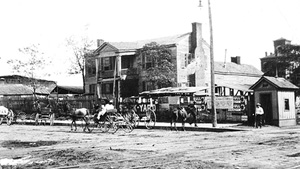Dr. Graves (1846-1921) moved to Dallas in his later years. He was a well known physician but perhaps less well known for his role in the story of the legendary Texas artillery pieces known as the “Twin Sisters” which played a role in the Texas Revolution.
The “Twin Sisters” refers to two field pieces (artillery pieces) donated by ladies of Cincinnati, Ohio to the cause of the Texas Revolution. According to an article in the Austin American-Statesman from 1874, they were two identical six pound rifle cannon that were built by a Mr. Tatum at a foundry in Cincinnati and shipped by riverboat to Texas. They were delivered in person by Mr. Tatum himself in time to be used by General Sam Houston in the Battle of San Jacinto. Following the Revolution they became prized relics and were known to have been fired at ceremonial occasions including the fifth anniversary of the Battle of San Jacinto and the inauguration of Houston as President of the Republic of Texas.
After 1845, their history becomes somewhat murky, but they were reportedly reunited again during the Civil War and used in the Battle of Galveston in defense of the port in 1863. By the end of the war though, they had disappeared. Some believe that they were buried in the general area of Buffalo Bayou near Harrisburg (now Houston), rather than have them be turned over to Union forces.
Dr. Henry North Graves believed that he was the last living person to know the whereabouts of the two historic cannon. Much of what we know about Dr. Graves comes from an obituary published in the Dallas Daily Times Herald and elsewhere around the state on June 28, 1921.
Dr. Graves was born in Plains Hill, Tennessee to Methodist minister Rev. Harrison A. and Rachel Bond Graves. At around the age of fourteen, Graves moved with his parents and family to Texas in 1860, settling near Gonzales. He joined the Confederate Army and as one of his postings, he served in the defense of Galveston Island during the war. In late 1869, Graves married the former Susan Davidson, a minister’s daughter. He then took up the study of medicine after which he practiced in Gonzales, Seguin and Georgetown. The couple were married almost twenty years until Susan died in 1888. Dr. Graves became known as an expert on anti-toxins. His obituary stated that he traveled throughout Texas, Louisiana and Arkansas where he taught serum-therapy.
During the Civil War, it is believed that Graves and four other individuals slipped away from the garrison at Galveston and buried two cannon in a field, rather than risk the field pieces falling under the control of Union forces. Graves fully believed them to be the Twin Sisters, but they have never been recovered, so it cannot be proven with certainty whether or not they were the two legendary field pieces.
Near the end of his life, Dr. Graves lived with his daughter Mrs. J. N. Bigbee and her family in Dallas, Texas on North Haskell Avenue, just out of downtown. Dr. Graves had desired to travel to Houston to assist in the recovery of the field pieces but had not been in good enough health to make the trip and died before it could happen. The obituary went on to state that he intended to make a search for the cannon if money could be raised for the effort. A resolution for the next session of the Texas Legislature was planned to secure funding for the project. Dr. Graves had however participated in a reunion of Confederate veterans about a year before his death. He had accompanied a group of the old veterans to a field that he identified as being the one where the cannon were buried, but did not give the exact location. Before the recovery effort could take place, Dr. Graves died in Dallas in late June of 1921 at the age of 74. He was buried along side his wife at Odd Fellows Cemetery in Georgetown, Williamson County, Texas.
There have been numerous attempts to document the fate of the Twin Sisters. Some accounts have them being used up to the end of the Civil War, up to and including the final Texas battle at Palmito Ranch. As of this writing however, their ultimate fate and location is considered to be unknown.
By Mike Magers


